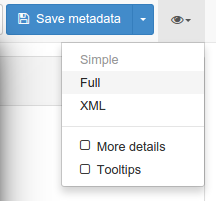Data quality¶
Lineage refers to the information or lack of information on the events and source data used to construct the dataset within the specified Scope, and specifies the source of data used to conduct or compile the current dataset. This section of metadata can enable greater reusability and credibility for your dataset.
Changing Views¶
Depending on the template you choose, the data quality section may not be visible in the general template. Switching to Full View while in record edit mode allows you full access to all of the available metadata fields. In GeoData’s edit page, switch to Full View to see the metadata grouped into sections.

Then navigate to the Quality tab at the top of this view.

Scope¶
Scope forms the top level of the data quality section and refers to the level of the data, what it covers, and the extent of characteristics for which data quality information is reported. In the Scope section, indicate:
Hierarchy level from the dropdown menu. Choices include Dataset, Non geographic dataset, Model, etc.
Add an Extent by choosing the + button next to that field – the Extent field section expands to reveal the following fields:
- Extent
Description: Describe the applicable extent.
Geographic element: Indicate the geographic area covered by the source data.
Temporal element: Indicate the start and end dates covered by the source data.
- Vertical extent
Minimum value, Maximum value: of the vertical extent, if applicable.
Vertical CRS: Choose the most appropriate value from a drop down menu.
- Level description
Scope description: describe the scope of the dataset here
Report: (this field currently does not work in GeoData)
Lineage¶
Lineage refers to information or lack of information on the process steps and source data used to construct this dataset within the specified scope. Indicate source of data used to conduct or compile the current dataset in this section.
Statement: Include a free-text description to summarize the lineage event you add.
Process step¶
- Create a separate process step to detail each set of actions performed on the data.
Description: A description of the process event conducted as part of the dataset project.
Rationale: The requirements or purpose for undertaking the action performed on the data.
Date/Time: The date the action/ process taken on the data was completed
- Processor - include information about the person or organization that performed the process step and how to contact them.
- Responsible party: choose from a pre-existing contact snippet or manually enter the following information:
Individual name, Organization name, position name,
- Contact information section
Telephone and Fax
Address: Delivery point (street address), city, administrative area (state), postal code, country, electronic mail address
Website – OnLine resource: Linkage,protocol, application profile, name of the resource (title), description, function (i.e. information or data)
Contact instructions: Add any special contact instructions in this field.
Role: choose “processor” from the role codes
Source¶
If your data derives from other data, indicate those sources in this section. This provides credit to the originators of that data and clarity as to how you arrived at the current dataset.
Description: Describe the source data used to build or compile your dataset. If you indicate a source dataset, this field is required if you omit the scale denominator.
Scale denominator: The extent of the source material represented by 1 over this number. If you indicate a source dataset, this field is required if you omit the source description.
Source reference system:
- Source citation: Include the relevant citation information for the material you used to compile the current dataset. This information provides credit to the originators of the data you used in this dataset.
Citation: Title, Alternate title, Date (created, published, or updated), Edition, Edition date, Citation identifier (i.e. DOI, handle)
- Cited responsible party: choose from a pre-existing contact snippet or manually enter the following information:
Individual name, Organization name, position name
- Contact information
Telephone and Fax
Address: Delivery point, city, administrative area, postal code, country, electronic mail address
Website – OnLine resource: Linkage,protocol, application profile, name of the resource, description, function
Contact instructions: Add any special contact instructions in this field.
Role: choose the appropriate designation for your contact from the drop down menu.
Other citation information fields include: Presentation form, Series, Other citation details, Collective title, ISBN, ISSN
Source extent: extent of the source material
Source step:
